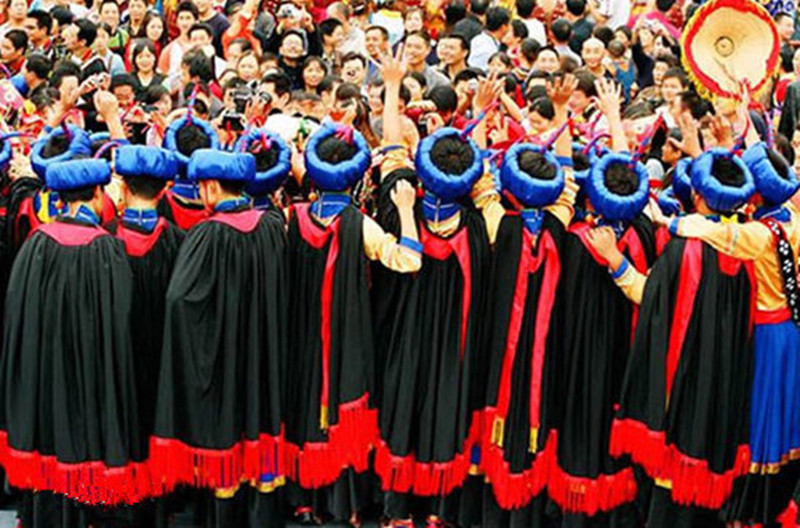
Hounan Festival of Bulang Ethnic Minority
Chinese Name:布朗族厚南节/桑刊节/宋坎节
English Name: Hounan Festival of Bulang Ethnic Minority
The Hounan Festival, also known as the “Sangkan Festival” or “Songkan Festival,” is a grand annual celebration of the Bulang ethnic group. It is held seven days after the Qingming Festival in the lunar calendar, which corresponds to April 13th to 15th in the Gregorian calendar. The main activity during the festival is splashing water on each other to welcome the sun, hence the festival is also known as the Festival of Welcoming the Sun. In recent times, the content of the Songkan Festival has evolved to include not only traditional activities but also performances of cultural programs and sports competitions, making it more popular among the people.
The Bulang ethnic group, with a population of 82,280, primarily resides in the Bulang Mountain area and the regions of Xiding, Bada, and Daluo in Menghai County, Xishuangbanna, Yunnan Province. Some also live scattered in Lincang and Simao.
Detailed Introduction of the Hounan Festival:
Festival Time
The specific date of the Hounan Festival is not fixed; it is generally held in October or November of the lunar calendar, with the exact date decided by the village elders and residents.
Significance of the Festival
The Hounan Festival aims to thank the earth for its harvest, worship ancestors and deities, and pray for favorable weather and abundant crops in the coming year. It reflects the Bulang people’s harmonious relationship with nature, their respect for ancestors, and their aspirations for a good life.
Festival Customs
- Ancestor Worship Ceremony On the day of the festival, the Bulang people dress in their finest attire and hold a solemn ancestor worship ceremony at the village altar or ancestral hall. The elders lead the people in worshiping their ancestors and thanking them for their protection.
- Agricultural Activities During the Hounan Festival, villagers symbolically engage in traditional agricultural activities such as plowing and sowing seeds, to relive the ancient farming lifestyle and express their hopes for a good harvest.
- Song and Dance Performances Throughout the festival, Bulang men and women, young and old, perform traditional songs and dances in the village square. The dances are vibrant and rhythmic, and the songs often praise nature, celebrate labor, and tell love stories.
- Food Sharing Villagers prepare abundant traditional foods such as sticky rice, bamboo-tube rice, and preserved meats. They gather to share the food, strengthening their bonds.
- Competitive Activities Traditional competitive activities like tug-of-war and wrestling are held during the festival, adding to the fun and showcasing the strength and beauty of the Bulang people.
- Handicraft Exhibitions Village artisans display their crafts during the Hounan Festival, including weaving, embroidery, and wood carving, helping the younger generation learn and pass on Bulang traditional skills.
Historical Legend
There is a beautiful legend about the origin of the Hounan Festival: it is said that long ago, after a severe drought, the ancestors of the Bulang people prayed for rain and eventually reaped a good harvest. Since then, the Bulang people have held the Hounan Festival every year after the harvest to express their gratitude to nature and their ancestors.
Festival Culture
The Hounan Festival is not only an important celebration of harvest and ancestor worship for the Bulang people but also a platform to showcase the rich culture of the Bulang ethnic group. Through this festival, Bulang cultural traditions are preserved and promoted, providing an opportunity for others to learn about the Bulang people.
The Hounan Festival is a significant traditional festival for the Bulang people, filled with reverence and gratitude for nature, ancestors, and life. It is a vital moment for displaying Bulang culture. By participating in the Hounan Festival, people can experience Bulang traditional customs and immerse themselves in the rich ethnic cultural atmosphere.

 7 Days GolfingTour
7 Days GolfingTour
 8 Days Group Tour
8 Days Group Tour
 8 Days Yunnan Tour
8 Days Yunnan Tour
 7 Days Shangri La Hiking
7 Days Shangri La Hiking
 11 Days Yunnan Tour
11 Days Yunnan Tour
 6 Days Yuanyang Terraces
6 Days Yuanyang Terraces
 11 Days Yunnan Tour
11 Days Yunnan Tour
 8 Days South Yunnan
8 Days South Yunnan
 7 Days Tea Tour
7 Days Tea Tour
 8 Days Muslim Tour
8 Days Muslim Tour
 12 Days Self-Driving
12 Days Self-Driving
 4 Days Haba Climbing
4 Days Haba Climbing
 Tiger Leaping Gorge
Tiger Leaping Gorge
 Stone Forest
Stone Forest
 Yunnan-Tibet
Yunnan-Tibet
 Hani Rice Terraces
Hani Rice Terraces
 Kunming
Kunming
 Lijiang
Lijiang
 Shangri-la
Shangri-la
 Dali
Dali
 XishuangBanna
XishuangBanna
 Honghe
Honghe
 Kunming
Kunming
 Lijiang
Lijiang
 Shangri-la
Shangri-la
 Yuanyang Rice Terraces
Yuanyang Rice Terraces
 Nujiang
Nujiang
 XishuangBanna
XishuangBanna
 Spring City Golf
Spring City Golf
 Snow Mountain Golf
Snow Mountain Golf
 Stone Mountain Golf
Stone Mountain Golf

















